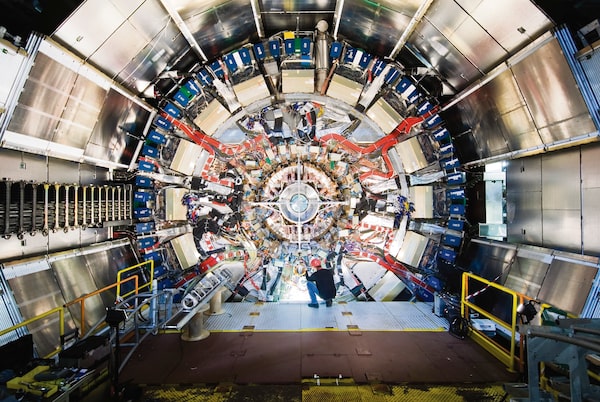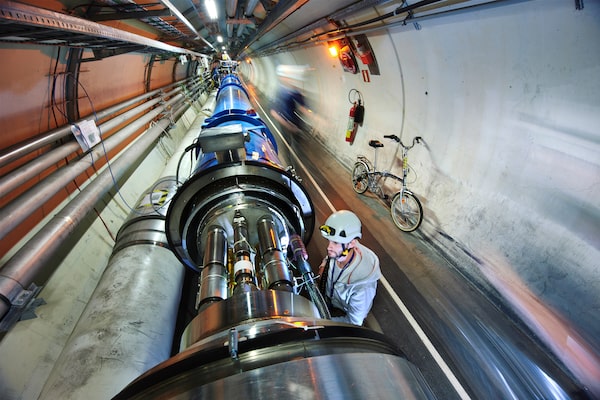
Scientists work on part of the massive ATLAS detector at the Large Hadron Collider during its initial installation in 2007.Claudia Marcelloni/Max Brice
In the verdant Rhône Valley just west of Geneva, an elaborate game of chance is about to begin.
At stake: the possibility of glimpsing nature’s deepest secrets. The bet: more than $400-million spent and more than three and a half years of labour by scientists across the globe to retool and reactivate the Large Hadron Collider, the most powerful particle accelerator ever built.
A decade ago, the LHC captured the world’s attention when it provided definitive proof of the existence of the Higgs boson, the elusive particle that completes the reigning theory of matter known as the Standard Model.
On Tuesday, one day after the 10th anniversary of that Nobel Prize-winning milestone, researchers will switch on their detectors and once again hope to use the LHC to spin scientific gold.
This time, their goal is not merely to journey to the edge of the unknown. It is to use whatever energy and guile they can muster to reach past that limit and grab hold of something – anything – that lies beyond the Standard Model’s inscrutable horizon.
No one disputes that there is something there to be found. There are too many unanswered questions and unexplained phenomenon for the current paradigm in particle physics to have the last word. The most glaring example is dark matter, an unidentified substance that pervades the universe but has no place in the Standard Model.
Whether the LHC can shed light on this or other mysteries is an open question. It is the gamble that thousands of researchers from more than 100 countries have made as they assemble this week to resume their exploration of the foundations of reality.
“People are so excited. It’s kind of the beginning of a new era,” said Manuella Vincter, deputy spokesperson for ATLAS, one of four giant particle detectors that are stationed along the LHC’s 27-kilometre-long ring. Canada is one of 42 countries contributing resources to the detector.
A professor of physics at Carleton University in Ottawa, Dr. Vincter has been based at the LHC since before the pandemic began. She said that COVID-19 slowed progress on upgrades to the collider, which has been in a scheduled shutdown since late 2018.
The resulting lack of new data coupled with two years of travel restrictions has stalled an entire cohort of young scientists who would have otherwise flocked to CERN, the European research centre where the LHC is located.
Now, said Dr. Vincter, there is a renewed sense of exuberance as the collider returns to action and researchers converge on CERN, eager to share what they’ve been working on.
On Monday, a special anniversary symposium will serve as a focal point, featuring many of the senior scientists who played a role in the Higgs discovery.
There is much to celebrate, though less than physicists might have hoped for back when the LHC began its first operational run in late 2009.
At that time, the Standard Model consisted of 16 particles that are the fundamental constituents of matter and energy. Three of those, including the up quark, the down quark (which combine to form protons and neutrons) and the electron, make up the atoms of our everyday world.
Most of the remaining particles are too short-lived to be observed except in physics experiments. Four of them – known as bosons because of their quantum properties – convey the forces that operate within and between atoms.
But even as the Standard Model was emerging in the 1960s, theorists recognized that something else was needed to explain many of its features, including why some particles have mass while others have none. The solution involves an additional boson that has the ability to endow mass based on the degree to which it interacts with other particles.
The explanation was first worked out in 1964 by British theorist Peter Higgs and independently by two other research teams. But it is Higgs whose name remains affixed to the particle they proposed.
To prove the idea correct, experimenters had to observe the Higgs boson in nature – not an easy task since the particle decays in less than one billionth of one trillionth of a second. It would take the LHC, which smashes together protons travelling in an accelerator ring at 99.9999991 per cent the speed of light, to do the job.
By tapping into the energy that is momentarily liberated during such collisions, the laws of physics allow particles, including Higgs bosons, to spring into existence with a certain probability. In the giant roulette wheel that is the LHC, protons collide about 40 million times per second within each detector, but only a thousand of those collisions may produce a Higgs boson.
Even then, the particle is too fleeting to detect, but its byproducts can be measured. By combining the results of many detections, the properties of the Higgs boson can be deduced to high precision.

The Large Hadron Collider tunnel during a shutdown.CERN
The run up to the Higgs discovery was an exhilarating time, said Mike Lamont, CERN’s director for accelerators and technology. Teams working in parallel with ATLAS and CMS, a separate detector, were leading the hunt.
“They knew something was there at the end of 2011,” he said. “So we came into 2012 really working to maximize the running of the machine to its peak, and then keeping it there as long as we could.”
The effort paid off. On July 4, 2012, representatives of both teams gathered in the main auditorium at CERN to present their results confirming the existence of the Higgs boson in a live-streamed briefing that became the LHC’s signature moment.
Many expected that other discoveries would soon follow, including previously unobserved particles pointing the way to a new theory beyond the Standard Model. Instead, the LHC has shown nature to be parsimonious. Even after the energy of the collider’s opposing proton beams were doubled for a second run starting in 2015, no such particles materialized.
Since then, the Higgs, once the prize, has became the tool in the search for subtle deviations from the Standard Model that might be hints of something new. What is most surprising about the results so far is how few surprises there are to report.
Pierre Savard, a University of Toronto physicist and ATLAS team member, said that when he was a graduate student in the 1990s there were plenty of colleagues who would have bet anything from “their car, their house, to the shirt off their back” that LHC, once built, would turn up something novel after the Higgs boson was found.
Instead, he said, “this Higgs boson is very much a Standard Model Higgs and the theory is working very well.”
Even so, at least one tentative clue has emerged in another one of the collider’s detectors, called LHCb. The clue amounts to a slight imbalance between observations of two ways that the bottom quark, one of the Standard Model particles, can decay.
The model predicts that the two modes should be equal, but LHCb has seen otherwise. With more data, the anomaly could disappear, just like the number of times a coin comes up heads or tails tends to even out the more the coin is tossed. But if the imbalance persists, the LHCb result could represent a genuine divergence from the known laws of physics.
In the meantime, work has progressed at squeezing as much performance out of the collider as possible for the third run, which commences this week. After three years of upgrades, collisions will only be marginally more powerful than before. But there are important differences in the way the energy of the proton beams will be utilized and how the detectors will operate to extract useful data at a higher rate.
The key challenge is not generating more collisions – the LHC already makes far more than any computer has the capacity to store – but choosing the ones that are most revealing. To get the most out of ATLAS, for example, scientists have installed new detector components to help distinguish the most interesting collisions.
“We’re actually hopeful that in three years, we can double the existing data set,” said Isabel Trigger, an ATLAS team member and research scientist at the TRIUMF particle accelerator in Vancouver.
Looking further out, Dr. Trigger said, she and her colleagues are already working toward a more ambitious fourth run of the machine called “high luminosity LHC” that could start as early as 2027, and see the collider continue operating until about 2040.
Dr. Lamont said he has already begun a feasibility study for a 91-kilometre accelerator ring that would pick up where LHC left off during the second half of this century. But whether such a machine will be built depends on what physicists are able to find between now and then to motivate the plan.
In the end, he said, “you do everything you can to make it right and then you have to stand back and see what happens. Nature’s not going to bend just because we’re looking.”
Editor’s note: A previous version of this story had an incorrect spelling for Isabel Trigger. The story has been updated to correct the error.
Our Morning Update and Evening Update newsletters are written by Globe editors, giving you a concise summary of the day’s most important headlines. Sign up today.